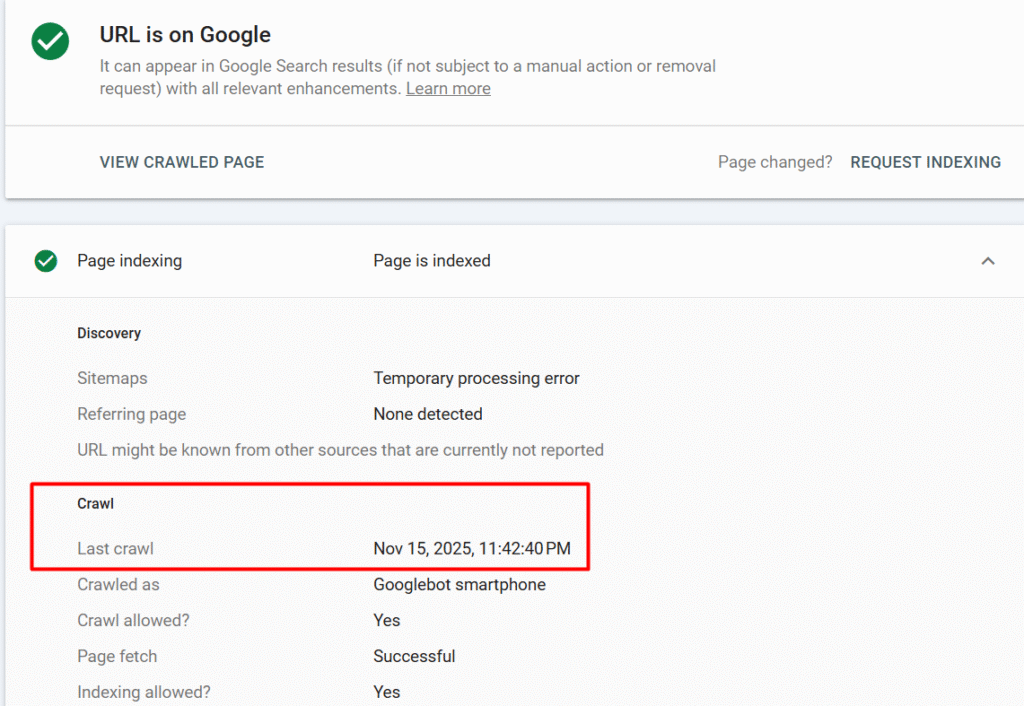Crawl frequency is one of the most important, but also one of the most ignored, concepts in technical SEO. Yes, you heard it right.
If you want Google to index your new posts quickly and update your old articles fast, you need a good crawl frequency.
Many bloggers or users think rankings depend only on keywords and backlinks, but Google will not even consider ranking your page if it is not crawled regularly.
In this blog, I will explain what crawl frequency means, why it matters, how to check it, and how you can increase it with simple steps.
What Is Crawl Frequency in SEO?
Crawl frequency refers to how often Googlebot or crawlers visit your website or a specific webpage within a certain time period.
It can be daily, weekly, or even on a monthly basis.
For example:
- If your homepage is crawled every day, then it refers to High crawl frequency.
- If your old blog gets crawled every 20 days, then it refers to Low crawl frequency.
Google decides crawl frequency based on many factors like website quality, content freshness, page speed, and internal linking etc.
Why Crawl Frequency Matters
Crawl frequency is closely linked to indexing and ranking. Here are the major benefits:
1. Faster Indexing
If Googlebot or crawlers visit your site frequently, your new blog posts will appear in search results faster. For news websites, Google crawls several times a day, but for new blogs or websites, it may take days or weeks.
2. Updated Content Gets Recognized
When you update content, Google needs to crawl it again to understand the changes. If your webpage is crawled regularly, Google picks up updates quickly and updates its ranking based on the new content.
3. Better SEO Performance
Webpages that Google crawls frequently are usually the ones Google finds valuable. These pages can get better presence in search results, faster updates, and more stable rankings. So, improving crawl frequency indirectly helps improve your overall SEO health.
Read Now: On-Page SEO Checklist for 2026
How to Check Crawl Frequency
Google does not show crawl frequency directly for each page, but we can easily check out crawl activity using the following methods:
1. Google Search Console (Under Crawl Stats)

You can find “Crawl Stats” Under the “Settings” section, which shows that
- Total crawl requests
- Pages crawled per day
- Crawl response time
- Host status
If your graph shows consistent crawling, it means Google is visiting your site regularly.
2. URL Inspection Tool
Google Search Console’s inspection tool shows when the page was last crawled. This helps you understand which pages Google finds important.
You can check the following example, when the page was last crawled:

3. Server Log Analysis
If you have access to server logs, check for the “Googlebot” user agent, where you can see:
- How many times has a URL been crawled
- Which URLs are ignored
- Which URLs are crawled too much
Why Your Crawl Frequency Is Low
If your blog or website gets crawled very slowly, there are some common reasons. You need to check and fix these issues
1. New or Low-Authority Website
New domains naturally get low crawl frequency because Google is not sure about your content quality yet.
2. Weak Internal Linking
If your pages are not connected properly, Googlebot will crawl fewer pages.
4. Too Many Errors (404, 500, Redirect Loops)
Crawling errors waste Google’s time. If your site has many errors, crawl frequency drops.
5. Outdated Content
If Google feels your site rarely updates content, it reduces crawling.
7. No XML Sitemap or Wrong Sitemap
If your sitemap is outdated, Google may not know which webpages to crawl.
8. URL Parameter Issues
Multiple variations and wrong URL structure of the same page confuse Google and waste crawl budget.
How You Can Increase Crawl Frequency
Here are the simplest ways to get Google to crawl your site more often:
1. Improve Website Speed
Fast websites get more crawling because Googlebot prefers quick-loading pages. You can check the following tips:
- Use good hosting
- Compress images
- Minify JS/CSS
- Use CDN
- Remove unused plugins
2. Strengthen Internal Linking
Internal links help Google move around your website easily. If Google can navigate your site better, crawl frequency automatically increases. You can check the following steps:
- Link new posts from older posts
- Link category pages internally
- Create a “Best Articles” page
- Link from homepage to important content
3. Update Content Frequently
If we update our content, it signals to Google that our website is active. You can implement the following steps.
- Updating old posts
- Adding new sections
- Refreshing outdated data
- Posting new blogs weekly
4. Submit a Sitemap in Google Search Console
You need to submit the sitemap to Google Search Console. The benefit of this, Google can easily crawl your webpages. But you need to check the following things as well.
- All important URLs should be present in the Sitemap.
- No 404 pages included in Sitemap.
5. Fix Crawl Errors
You should analyze your Google Search Console and check errors under Page Indexing. Here you can find the following issues:
- 404 errors
- Server errors
- Redirect loops
- Blocked pages
6. Build High-Quality Backlinks
You need to create backlinks on high domain authority websites. Even 2 to 3 good backlinks can boost crawl frequency. Backlinks attract crawlers faster because Googlebot follows links from other sites to yours.
7. Avoid Duplicate or Thin Content
You need to fix duplicate or thin content issues because it reduces your crawl value. Make sure every page has:
- Enough useful content
- Unique information
- Proper heading structure
8. Use Canonical Tags Correctly
You can use Canonical tags for the webpages, as it helps Google understand the preferred version of a page.
Does Crawl Frequency Affect Ranking?
Crawl frequency indirectly affects your keywords’ search rankings. You can check the following steps if your google ranking suddenly dropped.
- Faster indexing refers to faster ranking improvements.
- Google trusts sites with stable crawl patterns.
- Good crawl frequency helps new pages show up quickly in the Google Search Engine Results Page.
You can check this guide in detail if your Google Ranking has suddenly dropped.
Conclusion
Crawl frequency may sound technical, but it is actually simple. It shows how often Google visits your site, while crawl depth tells how deep Google goes into your pages.
By improving your website speed, fixing technical errors, using accurate internal links, and updating content regularly, you can easily increase crawl frequency. If your webpages are still not indexed by Google, then you need to do an in-depth website audit and fix the issues.
FAQ’s about Crawl Frequency
How often does Google crawl a website?
It depends on the website’s authority. Big websites are crawled daily, but new or small sites are crawled weekly or monthly basis.
How do I increase Google crawl frequency?
Improve page speed, add internal links, fix errors, submit sitemap, and update content regularly.
Does crawl frequency directly affect ranking?
Not directly, but higher crawl frequency leads to faster indexing, which helps rankings.

